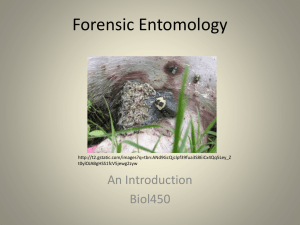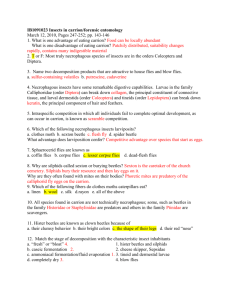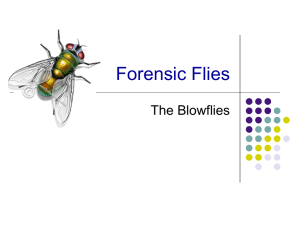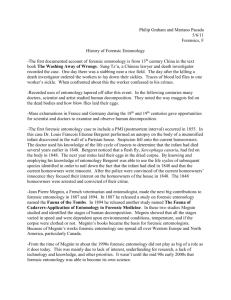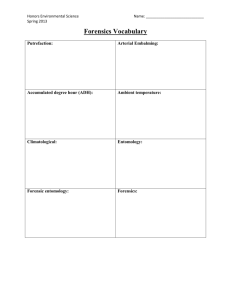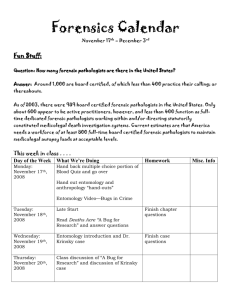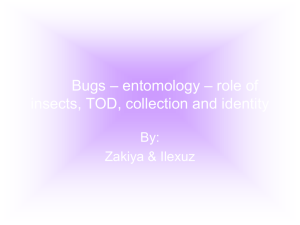Forensic Entomology FSC 462-662
advertisement
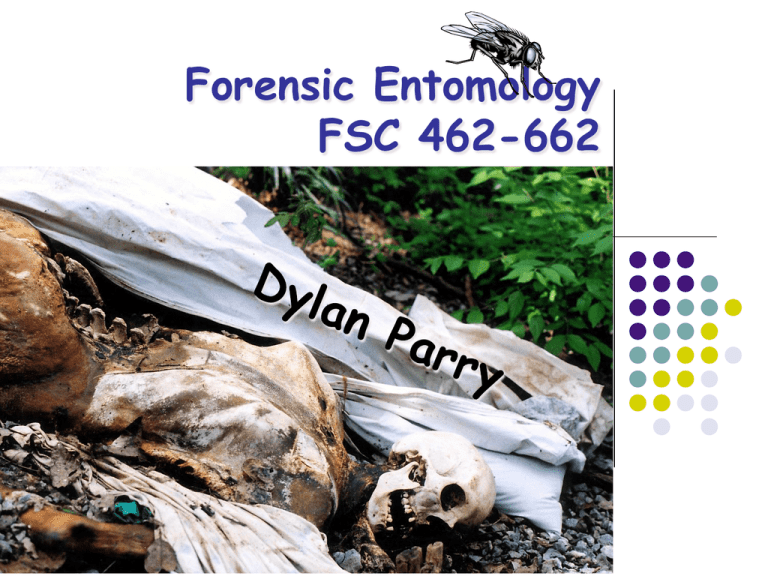
Forensic Entomology FSC 462-662 Dylan Parry Insect Ecologist Background: Dual PhD, Dept. of Entomology and Program in Ecology & Evolutionary Biology from Michigan State University) MS in Entomology (University of Alberta) What is Forensic Entomology? l Application of insects to legal issues. l Several categories, for the most part, I’ll be talking about medicocriminal forensic entomology. l Arthropods associated with crimes l Usually violent crimes such as murder, suicide, and rape, l Physical abuse and contraband trafficking. l Death investigations l Establishing timelines (time since death to time of discovery (postmortem interval or PMI) l Movement of the corpse, manner and cause of death. l Association of suspects with the death scene l Detection of toxins or drugs → insect larvae Brief History l l l Sung T’zu (1235) l First reference to forensic entomology l Use forensic entomology to solve a case of a long-dead infant Bergeret (1855) Megnin (1894) l l l l “La Faun des Cadavres: Application l’entomologie a la Medicine Legale” Hall 1948 l Monograph on identification of blowflies l Rekindled interest in the technique, published series of case histories Nuorteva (1970’s) Keh (1985), Smith (1986), Catts and Goff (1992) l Textbooks and reviews Stages of Decomposition l A. Fresh Stage (Days 1-2) l l B. Bloated Stage (Day 2-6) l l Abdominal wall breaks allowing gasses to escape. Carcass deflates. D. Post-decay Stage (Days 10-25) l l Putrefaction begins. Gasses produced by anaerobic bacteria inflate the abdomen. C. Decay Stage (Days 5-11) l l Commences at death, ends when bloating is first evident. Breakdown of protein and carbohydrates into simpler compounds In dry habitats, remains are skin, cartilage, and bones. In wet habitats, wet, viscous material in the soil under the remains. E. Dry Stage (Days 25+) l Mainly bones and hair remain. Odor is primarily that of normal soil and litter. Can last several months to years. Functional roles of Insect Associates of Cadavers l l l l Obligate necrophages – examples, blowflies, some beetles Facultative necrophages – ants, cockroaches, some flies, some beetles Natural enemies of necrophages – yellowjackets, ants Adventives – accidental species with no actual feeding relationship with cadaver Omnivores “Oh my!...What a cute little maggot!” Predators / Parasites Necrophages Adventives Succession A cadaver is a very rich but ephemeral resource l Competition intense among organisms, especially in the early stages of decomposition. l Insect colonization of a corpse occurs in a series of stages. l l l Different groups are adapted to different decompositional stages of a corpse. Thus, there is a fairly predictable sequence of colonization Major Groups of Necrophagous Insects Associated with Cadavers l Flies l l l l l Early: Blowflies Early: Flesh Flies Early: House Flies Late: Cheese Skippers Beetles l l Early/Mid: Carrion Beetles Late: Dermestids Succession and Decomposition Khloe and Kim Kardashian Snooki “Paris” Why Pigs? Omnivorous l Physiologically similar l Hairless l Similar morphology l Succession Fresh 1 Decay 4 2 Post-Decay 5 Bloated 3 Dry 6 Fresh Stage l l Blowflies have detected the cadaver Eggs are being laid, often around the eye, nostrils, mouth, followed by anus or genital openings Eggs Bloated Stage l l l l Cadaver begins to swell and putrefy Blowflies are still ovipositing Flesh flies appear Small maggots are feeding Small maggots Flesh fly Pig’s eye Decay Stage l l l Adult blowflies no longer attracted. Large masses of maggots feeding externally and internally Predators and parasitoids on maggots arrive Post-Decay Stage l Cadaver is drying out. Large maggots are leaving or have left Dry Stage l l Skin and bones Insects with the ability to digest keratin (clothes moths and dermestid beetles). Housekeeping l l l l l Course Page http://www.esf.edu/efb/parry/fsc 462_662_Home.htm I will post all lecture/lab material as PDF’s which you can download or read online. I also use the page to post other material to accompany lectures / labs I don’t use Blackboard

